
94% of researchers rate our articles as excellent or good
Learn more about the work of our research integrity team to safeguard the quality of each article we publish.
Find out more
ORIGINAL RESEARCH article
Front. Sustain. Food Syst., 21 March 2023
Sec. Nutrition and Sustainable Diets
Volume 7 - 2023 | https://doi.org/10.3389/fsufs.2023.1084973
This article is part of the Research TopicSustainable Food Consumption and Production in the 21st CenturyView all 22 articles
Introduction: Village tank cascade systems (VTCSs) were built in ancient Sri Lanka as autonomous and climate-resilient agro-ecological systems. This study examines crop choices, farming profitability, and environmental sustainability under alternative rainfall regimes and market interventions in the Mahakanumulla VTCS of the Anuradhapura district.
Method: A bio-economic model was developed to represent farming activities in the VTCS for the 2018-19 Maha and 2019 Yala cultivation seasons with data gathered from secondary sources and a key informant survey. The objective function of the model was the maximization of profits from farming. Resource limits were set for four types of land (highlands and lowlands in the Maha and Yala seasons), two types of labor (hired and family), and twelve-monthly water constraints. Six different models were developed for the six sub-divisions of the VTCS, considering the water-management hierarchy of the system. The models were simulated under alternative rainfall regimes and market interventions. The optimal crop mixes, farm profits, and shadow prices of resources associated with the baseline scenarios were compared with those of the counterfactual scenarios.
Results and discussion: This analysis clearly illustrated that water and labor are the key determinants of the system. Also, when 922 ha of lowlands and 205 ha of uplands were allocated per annum for crop cultivation under normal environmental conditions, the annual profitability of the VTCS was LKR 111 million. During drought periods, a sharp reduction in profits was observed in the Maha season. Year-round drought caused a 77% profit reduction compared to the baseline. The Maha drought alone caused a reduction of 47%. The introduction of a buy-back arrangement for chili and maize helped farmers to increase profits by 185 and 28%, respectively, under normal climate scenarios, turning to 954 and 5% during extreme drought scenarios, compared to the baseline. The least nitrate leaching and soil losses occurred in green chili cultivation. The introduction of market-based solutions is recommended to address extreme climate events experienced by the rural communities dependent on the VTCSs in Sri Lanka.
The immense diversity of climate and geography in Sri Lanka has resulted in correspondingly varied agricultural systems. The tank-based systems in the dry zone, termed village tank cascade systems (VTCSs), play an important role in the agrarian communities associated with them. VTCSs are interconnected small-tank systems which efficiently stored, conveyed, and used rainwater in the past. Distinctive crop-livestock systems and land-use patterns grew up around them. These systems have begun to degrade due to numerous natural and manufactured threats (Dharmasena, 2010). For example, rainfall data for the Mahailluppallama area during the last century reveals that the dry zone faced frequent climate shocks due to unpredictable rainfall patterns.
Additionally, macro-level policy changes have affected the system. After the Food and Agriculture Organization (FAO) declared VTCSs to be Globally Important Agricultural Heritage Systems (GIAHS), there were various technological and market interventions by the private and public sectors for their restoration. Nevertheless, there is a dearth of scientific investigation to evaluate the effects of such interventions on the profitability and environmental sustainability of VTCSs, except for two recent studies by Weerahewa and Dayananda (2023) and Dayananda et al. (2021) which used bio-economic models for the evaluation.
Bio-economic models, which may be developed as extensions of Linear Programming (LP) models, can assess farm innovations and government policies, considering the economic and ecological constraints in agricultural systems. Janssen and Van Ittersum (2007) introduced an integrated economic-hydrologic modeling framework that accounts for the interactions between water allocation, farmer-input choices, agricultural productivity, non-agricultural water demand, and resource degradation to estimate the social and economic gains from improvements in the allocation and efficiency of water use. There is also the Rosegrant et al. (2000) application of a bio-economic model to the Maipo river basin in Chile. The latter evaluated the economic benefits to water use for different demand management instruments, including markets in tradable water rights, based on the production and benefits functions of water in the agricultural and urban-industrial sectors (Rosegrant et al., 2000).
The objective of this study is to examine the profitability changes and environmental degradation of selected market interventions under alternative climate scenarios using a bio-economic model.
The Mahakanumulla VTCS in the Thirappane Divisional Secretariat was selected for this study. This VTCS is a branched cascade consisting of 27 village tanks spread across nearly 40 km2 in the Anuradhapura district (Figure 1). The village tanks in the VTCS drain to the Nachchaduwa tank, the last in the system, according to the elevation difference. The Department of Agrarian Services maintains the irrigation infrastructure of the Mahakanumulla VTCS which spreads across the six Grama Niladhari (GN) divisions of Mahakanumulla, Indigahawewa, Sembukulama, Wellamudawa, Paindikulama, and Walagambahuwa. A total 1,359 households live across the cascade; the community of 3,840 individuals breaks down to 53.6% women and 46.4% men (Department of Public Administration, 2019).
In keeping with the bi-modal rainfall pattern in the dry zone, there are two cultivation seasons, the Maha (wet season with high rainfall) and the Yala (dry season with low rainfall). There are different geographical and social characteristics across the VTCS, as well as individual agriculture systems based on its water-management hierarchy.
The basic LP model was adopted to develop a bio-economic model for the Mahakanumulla VTCS. The general form of the LP model is as follows.
Objective function:
Subject to,
The above model presents: Z as profit; Cj as the co-efficient of the jth decision variable; aij as the jth coefficient of the ith constraint; Xj as the jth decision variable; and, bi as the ith resource limit. The additional profits that may be reaped by increasing one unit of a limiting resource are indicated by the shadow price. A zero shadow price implies that no profits can be reaped by expanding use of the resource, i.e., the relevant resource is not binding. The shadow prices are the additional cost incurred over and above the market price by the decision maker when the resources are constrained as the cost of the resource is included in the coefficients of the objective function.
The basic version of the model is described below. Suppose that there are two types of crops, paddy and maize, and three constraints limit their production—lowland (LL), highland (HL), and water (W). For simplicity's sake, let us assume that the type of land is crop-specific. Maize uses HL and W to produce its output, while paddy uses LL and W for its output. Figure 2 shows the baseline equilibrium and counterfactual equilibria for this model. The feasible region is given by OABCD, and B or C will become the optimal solution in the initial equilibrium, depending upon the slope of the iso-profit line. If the relative price of maize is higher, as shown in Z, B becomes the optimal solution. If the relative price of paddy is higher, as shown in Z', C becomes the optimal solution. If the availability of LL is restricted, the feasible region shrinks to OABEF, and B or E will be the optimal solution status quo, with a lower profit compared to the initial equilibrium. If the availability of HL is expanded, the feasible region expands to OGHCD, and H or C will be the optimal solution in the status quo, with a higher profit compared to the initial equilibrium.
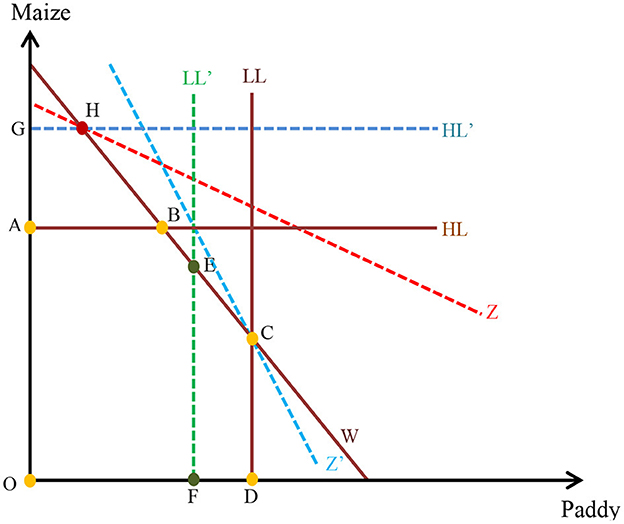
Figure 2. Graphical representation of the baseline equilibrium and counterfactual equilibria. Source: Adopted from Weerahewa and Dayananda (2023).
Decisions concerning administration of the cascade, water resource management, and cultivation are taken at the GN level. Accordingly, six different linear programming models were developed, treating the six GN sub-divisions as different agricultural systems. Of the six sub-divisions, three divisions show hydrological interconnections (WS 1, WS 2, and WS 3) and the connectivity was modeled through the water constraint. Each sub-division consists of available lands for cultivation, including lowlands and highlands. The total cultivation extents of each sub-division are presented in Table 1.
The extents of land cultivated with paddy, maize, and vegetables (the crops most under cultivation) in the 2018–2019 Maha and 2019 Yala were used to calibrate baseline models in each sub-division.
The baseline equilibria were calibrated thus. First, data concerning cultivation costs obtained from the Department of Agriculture (Table 2) and discussions with the key informants were used to construct the coefficients in the profit equation (cj) in the bio-economic model. Table 2 presents the data used to construct the baseline equilibria.
Next, the key constraints of the models of each sub-division were identified based on data from the key informant survey and secondary sources. The key informants were the Agriculture Research Inspectors for the Mahakanumulla VTCS, the presidents of the farmers organizations of the respective GN divisions, and the persons responsible for water operations in a season. Water, land, and labor are the significant constraints of the Mahakanumulla village tank system (Bandara, 2004; Withanachchi et al., 2014). Altogether, 18 constraints were identified, including two labor constraints, 12 monthly water constraints, and 4 land constraints representing lowlands and highlands in the Yala and Maha seasons.
The Crop Water Requirement (CWR) was calculated using the CROPWAT model (Food and Agriculture Organisation, 2022) and data from the Mahailuppallama weather station. The CWRs of the Yala and Maha seasons were calculated separately for each crop category. The starting date of the Maha season was taken as 1st October, and 1st March as the starting date for the Yala. The CWR was evaluated according to the crop growth stages. Table 3 illustrates the monthly CWR of paddy, maize, and vegetables in the dry zone.
The total water availability was computed using the CWRs and the crop mix generally adopted by the farmers in the study area. According to the literature and data from the key informant survey, cultivation is practiced using direct rainfall, tank irrigation, and groundwater resources in the VTCS. Groundwater is only used for chena cultivation (shifting, or slash-and-burn cultivation) in a few areas.
The average land extents of the VTCS were used in computing water usage during the two cultivation seasons: these numbers were then used to construct the water resource limits (bi) of the baseline equilibrium of the model. According to the key informants, in a typical Maha season, farmers cultivate the total extent of available lowland with paddy. In a typical Yala season, only one-third of the lowland is cultivated. The total available water in the baseline scenario is presented in Table 4.
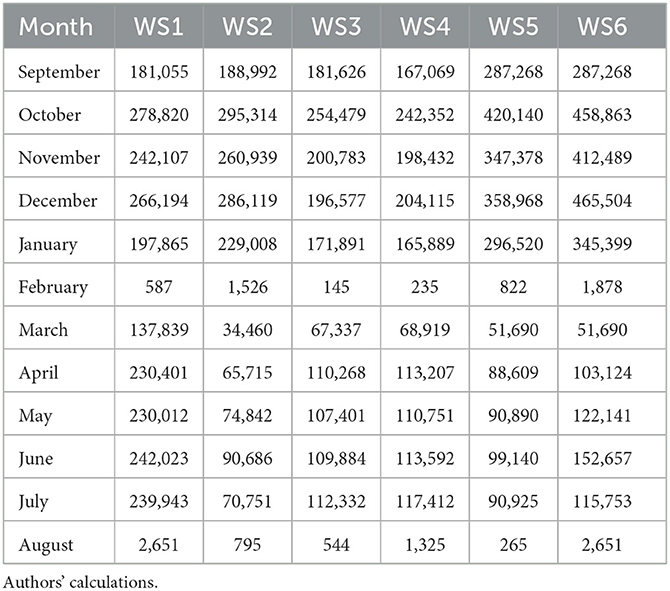
Table 4. Total water available for cultivation in the six sub-divisions in the baseline scenario (m3).
The average labor requirements for each crop category, obtained from the cost of cultivation reports produced by the Department of Agriculture, were used to construct the constraint coefficient of the labor. The limit on the total labor requirement was determined considering the labor required for each crop enterprise and was obtained from the cost of cultivation reports of the Department of Agriculture and the crop mix generally adopted by the farmers in the study area (Department of Public Administration, 2021).
Appendix 1 presents the model tableau for the baseline scenario for a single sub-division in the Mahakanumulla VTCS.
The profitability of crop cultivation under market interventions was tested under alternative climate scenarios experienced in the dry zone during the past decade.
Climate impacts on the VTCS were tested as an external shock. Rainfall data from the Mahailluppallama weather station for the 1976–2019 period, obtained through the Anuradhapura District Survey Office, were taken into account to generate the drought scenarios. Figures 3, 4 present monthly rainfall distribution during the Maha and Yala seasons from 2009 to 2019.
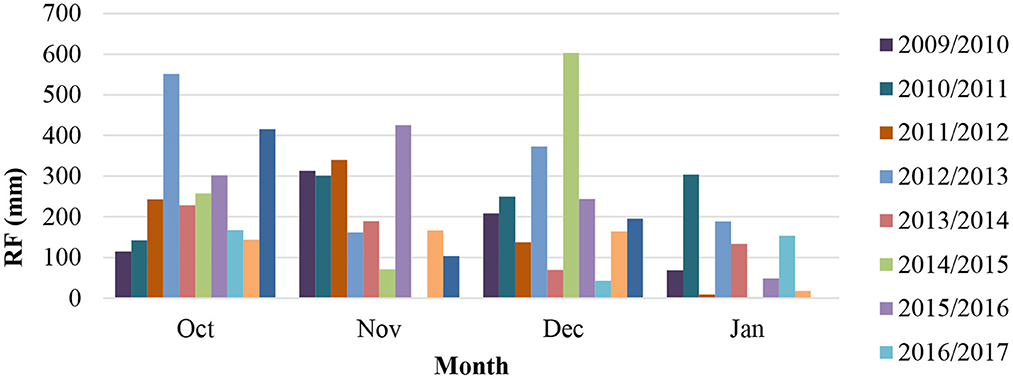
Figure 3. Rainfall distribution in the Maha season (2009–10 to 2018–19). Source: District survey office, Anuradhapura.
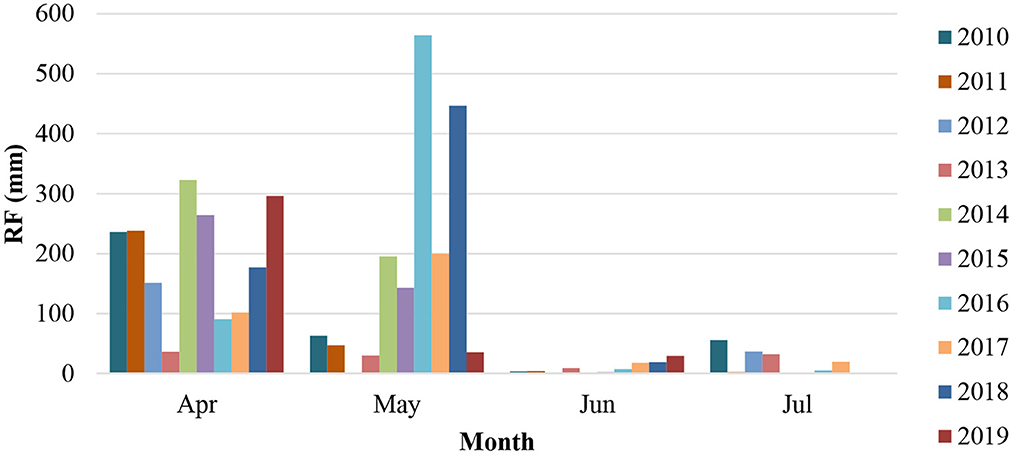
Figure 4. Rainfall distribution in the Yala season (2009–2019). Source: District survey office, Anuradhapura.
Of the Maha seasons, 1986–87 and 2012–13 recorded the lowest and highest rainfall, respectively. Therefore, the 1986–87 Maha rainfall was considered the Maha drought period. From the Yala seasons, the 1979 and 2018 seasons received the lowest and highest rainfall, respectively; thus, the 1979 Yala rainfall was taken as the Yala drought period.
The baseline scenario was developed considering the rainfall received during the 2018–19 Maha and 2019 Yala seasons which depict rainfall in an average rainy year. In determining the past decade's rainfall data, six rainfall scenarios were developed to test the effect of climate shocks on the Mahakanumulla VTCS. Table 5 presents the above rainfall scenarios and the monthly average rainfall for the above scenarios.
In order to calculate direct rainfall to the crop cultivation area, the extent of land cultivated in each sub-division was used. Then, the baseline models simulated the total available water under each scenario. Profitability, land use, environmental sustainability, and shadow prices were calculated for each subdivision and the entire cascade.
Government policy, as articulated in the National Policy Framework Vistas of Prosperity and Splendor, Overarching Agricultural Policy, and National Agricultural Policy, emphasize the need to introduce market interventions to uplift rural lives without compromising environmental sustainability. Accordingly, one initiative by the private sector in many dry zone areas has been a buy-back system for maize and chili. Even though tobacco was also introduced as a commercial crop, in compliance with World Health Organization (WHO) guidance on tobacco control, the government has decided to disincentivise tobacco cultivation. In this study, we tried to assess the profitability changes, considering the buy-back systems for maize, dried chili, and tobacco.
The baseline bio-economic models were extended by including the above crop categories to evaluate the effects of market interventions. Tables 6–8 represent the data used for the market intervention scenario.
The extent of environmental degradation associated with different crop plans was evaluated using estimations of soil loss and nitrate leaching for each crop mix. According to Mapa et al. (2007), the lowlands of the dry zone consist of Low Humic Glay (LHG) and Reddish Brown Earth (RBE) soils. According to the data, 70.5% of the available lands for cultivation in the Mahakanumulla VTCS are lowlands. Soil loss was estimated using published soil loss estimations by various scientific studies (Table 9). The nitrate leaching amount was calculated using estimates from Kanthilanka (2022). Nitrate leaching at the field level for rice and maize during the Yala and Maha seasons for the varied rate of N application in LHG poorly-drained soil is as follows.
Nitrate leaching and soil loss were calculated for each sub-division and summed up to obtain the entire system's environmental degradation (Table 9).
The baseline model was calibrated drawing on cultivation data for the 2018–2019 Maha and 2019 Yala seasons. During these two seasons, the Mahakanumulla VTCS received a total annual rainfall of 1.63 m. This was a good year, compared with the average rainfall for the years 1979–2019. According to records from the Mahailluppallama weather station, the average rainfall during this period was 1.4 m, with a 0.3 standard deviation.
Table 10 shows the results of the profitability and decision variables of the six sub-divisions. The total profitability of the entire cascade system was derived from the profitability value of the six sub-systems. Profitability was determined by the amount of water, lowlands, and highlands and the number of person-days available for agriculture activity in each subsystem.
As indicated earlier, the 2018–19 Maha and 2019 Yala seasons show the baseline scenario, and this is a year with average rainfall. In such an year, the cascade has earned around LKR 111 million in annual profit through cultivating 922 ha of lowlands and 205 ha of highlands. Figure 5 depicts the annual land use of the three major crops cultivated in the Mahakanumulla VTCS, as shown by the above results, in a year where average rainfall and lowlands are utilized thoroughly during the Maha season in each sub-division. However, the entire lowland area is not cultivated in the Yala season due to insufficient water. The same pattern can be seen with the cultivation of the highlands.
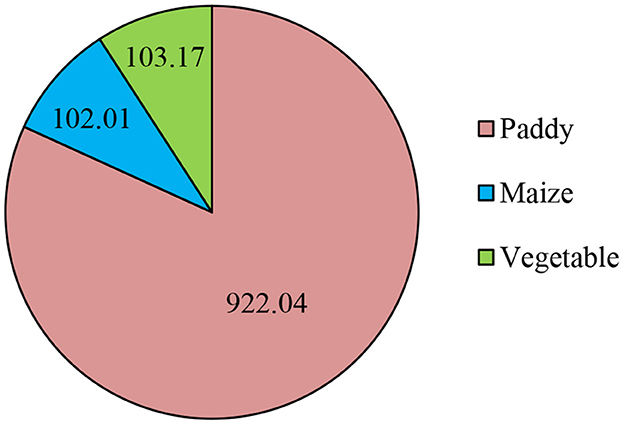
Figure 5. Annual land use in the Mahakanumulla VTCS under the baseline scenario (ha). Source: Authors' calculations.
The analysis underlines the comparatively low net profits from rice cultivation, despite it being the dominant crop in both seasons. The sub-divisions with the larger lowland areas generate higher profits than the rest. The sub-divisions located near the Nachchaduwa tank (at the lower end of the VTCS) show higher profitability, compared with sub-divisions at the upper end, due to the high availability of water.
In terms of shadow price, it is clear that irrigation water is a constraint in the upper sub-divisions. Similarly, the profitability of the sub-divisions near the Nachchaduwa tank is limited by the scarcity of land, despite water availability. Therefore, the analysis results highlight irrigation water and land as the key determinants of the optimal crop mix and profitability of the Mahakanumulla VTCS under the current scenario.
The results of the shadow prices in Table 11 show that the eight-monthly water constraints were binding. Both the Maha and Yala end-season water constraints were binding, which will affect the late growth stages of the crop cycle and ultimately result in lower harvests. The most significant effect was caused by water limitation in February. Water constraints at the end of both seasons directly affected the cultivation of maize in that area.
The possible environmental impact of the current cultivation pattern on the Mahakanumulla cascade is presented by Figures 6, 7. Following Kanthilanka's (2022) equations, given the nature of the dry zone soil and other external factors, the nitrate leaks and soil loss in this LHG-rich system are demonstrated here. Accordingly, about 6,662 tons of soil are removed from the system annually due to cultivation during the regular rainy season and about 34 tons of nitrates are leaked.
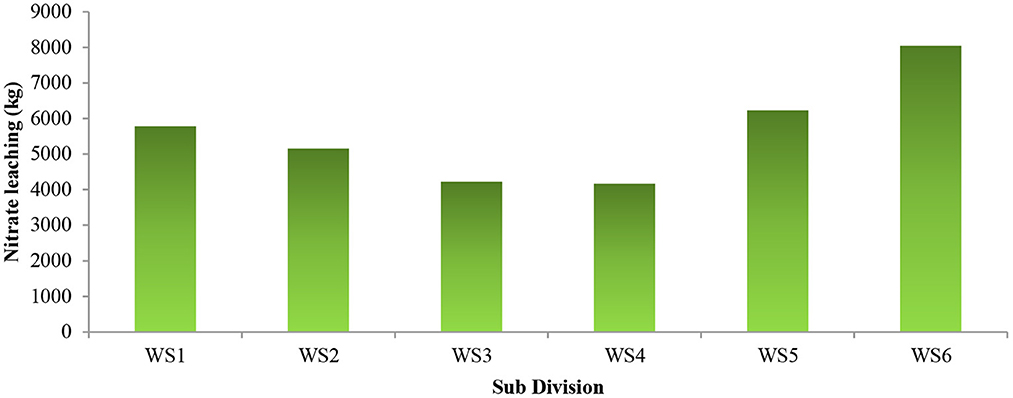
Figure 7. Nitrate leaching of each subdivision under the baseline scenario. Source: Authors' calculations.
Similarly, there is high profitability and environmental damage in the lower section of the cascade. Wickramasinghe et al. (2023) and Kulasinghe and Dharmakeerthi (2022) have supported this finding in the same cascade, indicating that high accumulation of nitrate and phosphate in lower watersheds. Further, this finding supports Bandara et al. (2010) who indicated higher nitrate, PH, and sulfate accumulation at the lower end of the Parana Halmillawa, Navodagama, Sandamal Eliya, Kahagollewa, and Puwarasankulama cascades in the dry zone. Among the baseline crop mix, maize causes the highest nitrate leaching, followed by paddy and vegetables. However, soil loss is comparatively lower in paddy than in the other two crop categories. Thus, the cash crops are more environmentally damaging. As a result, higher profits are always associated with more significant environmental damage.
The Mahakanumulla cascade system is subject to constant climatic influences. Based on the variation in rainfall over the last century, it showed extreme changes in rainfall. The equilibrium in the baseline was simulated with lower or higher water availability in the cultivation seasons to obtain the equilibrium under each climate scenario. Table 12 presents the profitability of farming in the Mahakanumulla VTCS under a good rainfall year, good Maha rainfall, good Yala rainfall, Yala drought, Maha drought, and year-round drought scenarios, respectively. The total profitability of the VTCS was taken using the summation of the profitability under each sub-division scenario.
The rainfall data used for this analysis show that during the worst drought of the last century, the annual rainfall was 82.7% less than the average annual rainfall. Similarly, the highest annual rainfall in the last century shows an increase of 40.1% over the average annual rainfall.
The profitability results of the Mahakanumulla VTCS demonstrate water availability to be the driving factor of the cascade system. Table 12 presents crop cultivation patterns under extreme weather events. Profits resulted in the higher rainfall regimes being higher than average rainfall years. Year-round good rainfall generates the highest return to the cascade. Marques et al. (2005) similarly reported that the reliability of increased water supplies raised the probability of higher crop economic returns.
As might be surmised, there were lower profits associated with drought situations than during good rainfall regimes (Table 12). Furthermore, the profit results reflect that drought during the Maha season had a higher impact on profitability than in the Yala season. The results of each sub-division show that farmers moved on to crops requiring less water than paddy in dry spells. At the same time, smaller extents of land would be cultivated in the Yala season due to lower water availability. There is a higher profit during the Yala drought than in the other two drought scenarios: the reason is that water scarcity leads to the selection of crops requiring less water, like maize and vegetables, over paddy.
Figure 8 presents the extents of land cultivated annually with the three major crops in the Mahakanumulla VTCS. Culturing high-income generation crops, such as maize, under high water availability resulted in higher returns to the system. 71.4% of highlands were utilized under heavy rainfall, a 51.7% increase compared with the baseline scenario. There is only 13.9% of highland cultivated under a year-round drought scenario. The largest extent of lowland cultivated under the baseline scenario is 62% of the total available lowlands in the VTCS. Annual lowland cultivation will reduce to 26.6% under heavy rainfall conditions and to 9.5% under year-round drought.
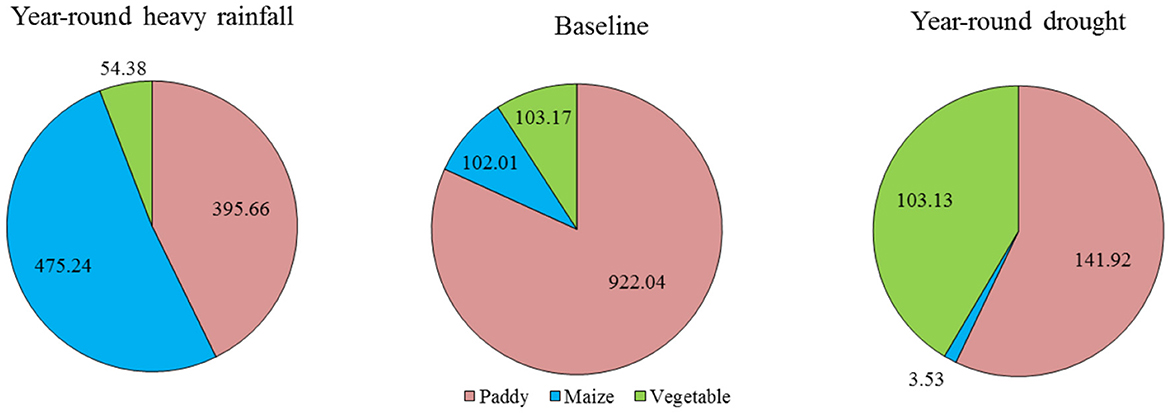
Figure 8. Annual land Use (ha) in the Mahakanumulla VTCS under baseline, year-round drought, and year-round heavy rainfall scenarios. Source: Authors' calculations.
The following figures show the environmental damage during the climate scenarios.
As per the calculations of soil loss and nitrate leaching under alternative climate scenarios, the highest soil loss resulted under a heavy rainfall year. According to Figures 9, 10, it is evident that environmental degradation is proportionate to profitability. Drought leads to less soil loss than the baseline. Figure 10 shows that nitrate leaching is high in the baseline scenario compared with the heavy rainfall year. Farmers are moving toward maize farming rather than other crop cultivations with heavy rainfall.
Dry zone agricultural systems are directly affected by changing political and trade policies. As mentioned earlier, tobacco could invade the crop lands in the dry zone as a commercial crop, and the government suggested introducing maize and green chili buy-back arrangements as potential alternatives for this issue.
The changes in profitability under these market interventions were estimated under several assumptions: the introduction of buy-back arrangements ensuring the availability of inputs for cultivation, certified farm-gate prices and a well-established market for farm outputs. We examined the extent to which market interventions affect the profitability of the Mahakunumulla VTCS under the above conditions. The profitability changes in the Mahakanumulla VTCS under different market interventions and alternative climate scenarios are presented in Table 13.
As shown in the table above, any market intervention can increase the profits reaped in the baseline scenario. The same pattern can be found in all the sub-systems, and similar results can be shown in all climate scenarios. The comparison of profits under alternative market interventions illustrates that annual profits are higher when maize, tobacco, and green chili crops are cultivated simultaneously. Similar results were reported by Chianu et al. (2009) with reference to soybean farming in Kenya and by Reddy and Suresh (2009) in India with regard to oil seed crops.
Of the three market interventions, chili provides relatively higher returns than the buy-back arrangements for the other two crops, with higher profits in the drought periods when compared with periods of excellent rainfall. According to the results, introducing a cash crop, such as green chillies, into a cascade system would yield the highest returns. However, the other crops of the Maha season would not come into the crop mix, farmers would be tempted to cultivate green chillies using all available resources. Green chili cultivation increases the profitability of this VTCS system by about 185% during a regular rainy season.
Introducing maize buy-back arrangements with a well-established market will lead to high profits for the VTCS. However, at that time all crop choices came to the crop mix in VTCS based on the available resources. Accordingly, the increase in the profitability from introducing maize buy-back cultivation during an average rainfall period is 28%.
Tobacco also shows a similar pattern, suggesting that buy-back arrangements would be profitable in each climate scenario. This would enable farmers to cultivate under less water availability. However, while tobacco yields higher economic returns than maize during the baseline year, maize yields higher economic returns under extreme climatic conditions.
Figure 11 summarizes land use under alternative climate and market interventions. According to the results, paddy cultivation accounts for the most annual use of land in the VTCS, except when green chili is grown. But when maize buy-back arrangements are introduced under heavy rainfall years, then maize dominates up to 22.5% of total available lands. As shown in Figure 11 tobacco becomes more dominant in land use under droughts than in the other two climate scenarios. Even though the introduction of green chili dominates annual land use in all three climate scenarios, the greatest extent resulted under the baseline scenario. However, under the above market interventions, dry zone vegetables no longer enter the annual land use pattern.
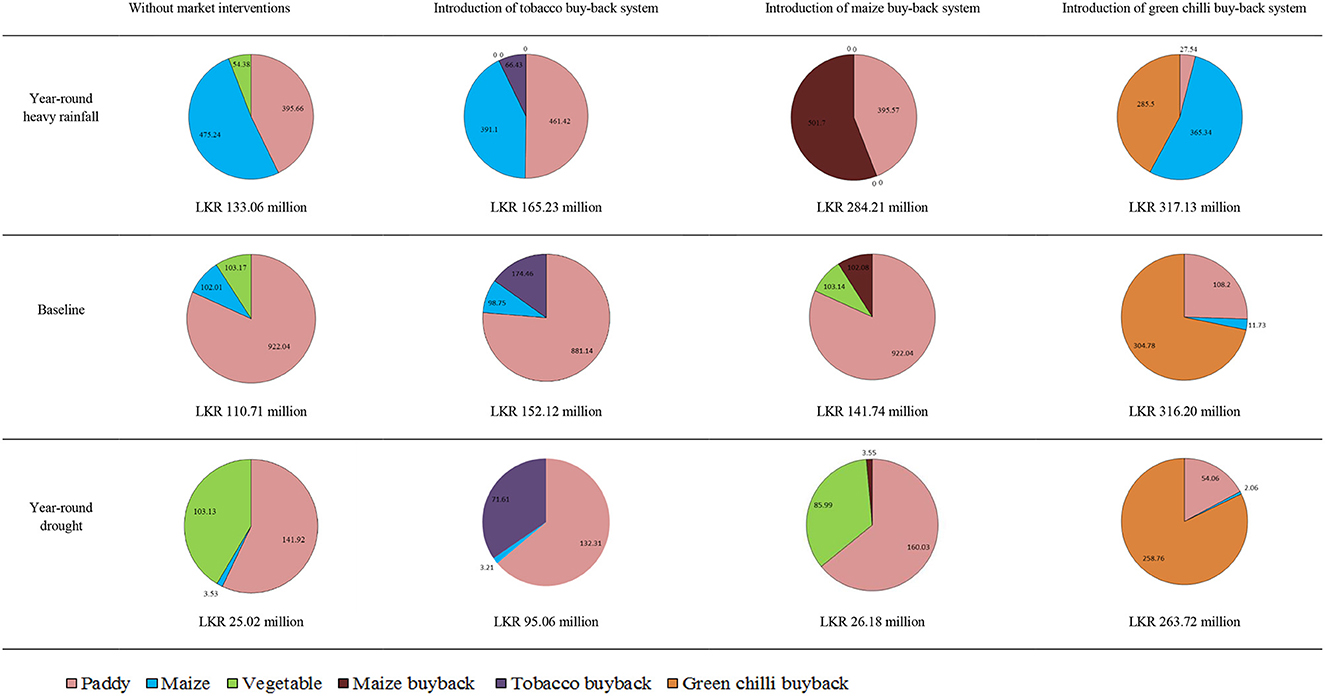
Figure 11. Land use in the Mahakanumulla VTCS under alternative market scenarios. Source: Authors' calculations.
According to the results of the soil loss and nitrate leaching calculations, introducing green chili is the most environmentally sustainable intervention under a good Maha rainfall scenario (Figures 12, 13). Also, Figure 12 shows that tobacco cultivation causes very high soil losses. Similar findings were reported by Thomaz and Antoneli (2022) in southern Brazil. However, nitrate leaching and soil losses due to market interventions other than tobacco are lesser or similar to losses under the current crop pattern. These trends have been observed in every climate scenario.
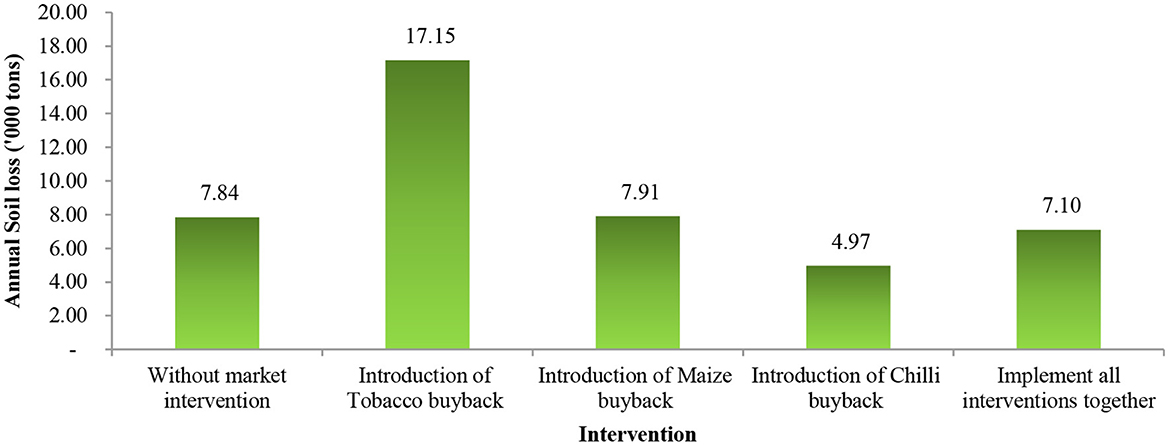
Figure 12. Soil loss under different market interventions—heavy Maha rainfall. Source: Authors' calculations.

Figure 13. Nitrate leaching under different market interventions—heavy Maha rainfall. Source: Authors' calculations.
The results of the simulations revealed that green chili and maize buy-back systems are possible alternative crops for tobacco. With green chili crops present, tobacco will not enter the system under the climate scenarios examined in this study.
In light of the key findings of the simulation exercises, several conclusions may be drawn. The results demonstrate irrigation water to be the key determinant of the optimal crop mix and, hence, the profitability of farming in the Mahakanumulla VTCS. Therefore, drought conditions lead to severe economic losses in this system, with year-round and seasonal droughts having the most significant impact. Water availability at the mid-stage is the most binding, resulting in a drastic reduction in crop cultivation in this area.
The following policy recommendations are proposed based on the conclusions of this study.
I. Develop drought risk profiles at the national level to capture risk and assess damage. Dry zone VTCSs face drought shocks which lead to drastic profit losses and food insecurity. The introduction of possible alternatives to mitigate profit losses, along with identified damages, is a viable solution.
II. Introduce buy-back market arrangements to the VTCSs. Resources can be used to maximum potential and profitability restored under extreme climate scenarios by introducing buy-back arrangements for maize and chili.
III. Discourage tobacco cultivation and introduce alternative crops. Though tobacco generates relatively high profits in cascade systems, it also causes tremendous soil loss and nitrate leaching compared with other alternatives.
The raw data supporting the conclusions of this article will be made available by the authors, without undue reservation.
DD, JW, and SW designed the model and the computational framework and analyzed the data and carried out the implementation. DD performed the calculations and wrote the manuscript with input from other two authors. JW and SW conceived the study and were in charge of overall direction and planning. All authors contributed to the article and approved the submitted version.
This work was financially supported by the World Bank-funded AHEAD project (AHEAD/RA3/DOR/STEM/PDN/No 52) administered by the Ministry of Higher Education, Sri Lanka.
The authors declare that the research was conducted in the absence of any commercial or financial relationships that could be construed as a potential conflict of interest.
All claims expressed in this article are solely those of the authors and do not necessarily represent those of their affiliated organizations, or those of the publisher, the editors and the reviewers. Any product that may be evaluated in this article, or claim that may be made by its manufacturer, is not guaranteed or endorsed by the publisher.
Arunathilake, N., and Opatha, M. (2003). The Economics of Tobacco in Sri Lanka. Washington, DC: World Bank. Available online at: http://localhost:4000//entities/publication/13fdae84-daba-509b-9f28-21d4bb042c6a
Bandara, C. M. (2004). Small tank cascade systems: their relevance for minor irrigation rehabilitation. Small Tank Settlements in Sri Lanka 43–47.
Bandara, C. M., Yatigammana, S., and Paranavithana, G. (2010). Scientific validation of some traditional land and water management practices under village tank cascade systems. Econ. Rev. 36, 1–18.
Chianu, J. N., Ohiokpehai, O., Vanlauwe, B., Adesina, A., De Groote, H., Sanginga, N., et al. (2009). Promoting a versatile but yet minor crop: Soybean in the farming systems of Kenya. J. Sustain. Develop. Africa 10, 324–344.
Department of Public Administration. (2019). Sampath Pethikada Thirappane 2019. Thirappane: Divisional Secretariat.
Dayananda, D., Weerahewa, J., and Weerasooriya, S. A. (2021). Water availability, crop choices, and profitability of farming: a case study of Mahakanumulla tank village. Trop. Agric. Res. 32, 81–94. doi: 10.4038/tar.v32i1.8444
Department of Public Administration (2021). Sampath Pethikada Thirappane 2021. Sri Lanka: Divisional Secretariat, Thirappane.
Dharmasena, P. B. (2010). “Essential components of traditional village tank systems,” in Proceedings of the National Conference on Cascade Irrigation Systems for Rural Sustainability (Sri Lanka: Central Environmental Authority).
Food Agriculture Organisation (2022). Land and Water; Cropwat. Available online at: https://www.fao.org/land-water/databases-and-~software/cropwat/en/ (accessed June 05, 2022).
Janssen, S., and Van Ittersum, M. K. (2007). Assessing farm innovations and responses to policies: a review of bio-economic farm models. Agric. Syst. 94, 622–636. doi: 10.1016/j.agsy.2007.03.001
Kanthilanka, H. (2022). Evaluation of Nitrogen Fertiliser Decisions by Rice Farmers: Accounting for the Effects of Nitrate on Water Quality for Communities in Cascaded Village Tank Systems in Sri Lanka. [Unpublished doctoral dissertation, University of Melbourne].
Krishnarajah, P. (1982). Soil Erosion and Conservation in the Upper Mahaweli Watershed, Joachim Memorial Lecture (Colombo, Sri Lanka: Annual Session of the Soil Science Society of Sri Lanka), p. 13.
Kulasinghe, T. N., and Dharmakeerthi, R. S. (2022). Effects of land use type and tank components on soil properties and sustainability of tank cascade system in the Dry Zone of north central Sri Lanka. Agric. Syst., 201, 103474. doi: 10.1016/j.agsy.2022.103474
Mapa, R. B., Somasiri, S., and Dassanayake, A. R. (2007). Soils of the Dry Zone of Sri Lanka. Morphology, Characterization and Classification. Special publication No. 7. (Soil Science Society of Sri Lanka, Survodaya Publishers). p.8.
Marques, G. F., Lund, J. R., and Howitt, R. E. (2005). Modeling irrigated agricultural production and water use decisions under water supply uncertainty. Water Resour. Res. 41, 8. doi: 10.1029/2005WR004048
Reddy, B. N., and Suresh, G. (2009). Crop diversification with oilseed crops for-maximizing productivity, profitability and resource conservation. Indian J. Agronomy 54, 206–214.
Rosegrant, M. W., Ringler, C., McKinney, D. C., Cai, X., Keller, A., Donoso, G., et al. (2000). Integrated economic-hydrologic water modeling at the basin scale: the Maipo river basin. Agric. Econ. 24, 33–46. doi: 10.1111/j.1574-0862.2000.tb00091.x
Thomaz, E., and Antoneli, V. (2022). Long-term soil quality decline due to the conventional tobacco tillage in southern Brazil. Archives Agronomy Soil Sci. 68, 719–731. doi: 10.1080/03650340.2020.1852550
Weerahewa, J., and Dayananda, D. (2023). Land use changes and economic effects of alternative fertilizer policies: a simulation analysis with a bio-economic model for a Tank Village of Sri Lanka. Agric. Syst. 205, 103563. doi: 10.1016/j.agsy.2022.103563
Wickramasinghe, M. R. C. P., Dayawansa, N. D. K., Jayasiri, M. M. J. G. C. N., and De Silva, R. P. (2023). A study on external pressures of an ancient irrigation cascade system in Sri Lanka. Agri. Syst. 205, 103593. doi: 10.1016/j.agsy.2022.103593
Withanachchi, S. S., Köpke, S., Withanachchi, C. R., Pathiranage, R., and Ploeger, A. (2014). Cross scale dynamics in dry zonal paddy cultivation in Mahaweli river basin, Sri Lanka: an analysis of spatial and temporal climate change impacts in water resource management. Climate 2, 329–354. doi: 10.3390/cli2040329
Keywords: village tanks, bio-economic modeling, crop mix, irrigation, Sri Lanka
Citation: Dayananda D, Weerahewa J and Weerasooriya SA (2023) Resource-use efficiency and environmental sustainability in the village tank cascade systems in the dry zone of Sri Lanka: An assessment using a bio-economic model. Front. Sustain. Food Syst. 7:1084973. doi: 10.3389/fsufs.2023.1084973
Received: 31 October 2022; Accepted: 01 March 2023;
Published: 21 March 2023.
Edited by:
Muhammad Asad Ur Rehman Naseer, Bahauddin Zakariya University, PakistanReviewed by:
Salman Sarwar, The University of Queensland, AustraliaCopyright © 2023 Dayananda, Weerahewa and Weerasooriya. This is an open-access article distributed under the terms of the Creative Commons Attribution License (CC BY). The use, distribution or reproduction in other forums is permitted, provided the original author(s) and the copyright owner(s) are credited and that the original publication in this journal is cited, in accordance with accepted academic practice. No use, distribution or reproduction is permitted which does not comply with these terms.
*Correspondence: Jeevika Weerahewa, amVldmlrYS53ZWVyYWhld2FAYWdyaS5wZG4uYWMubGs=
Disclaimer: All claims expressed in this article are solely those of the authors and do not necessarily represent those of their affiliated organizations, or those of the publisher, the editors and the reviewers. Any product that may be evaluated in this article or claim that may be made by its manufacturer is not guaranteed or endorsed by the publisher.
Research integrity at Frontiers

Learn more about the work of our research integrity team to safeguard the quality of each article we publish.